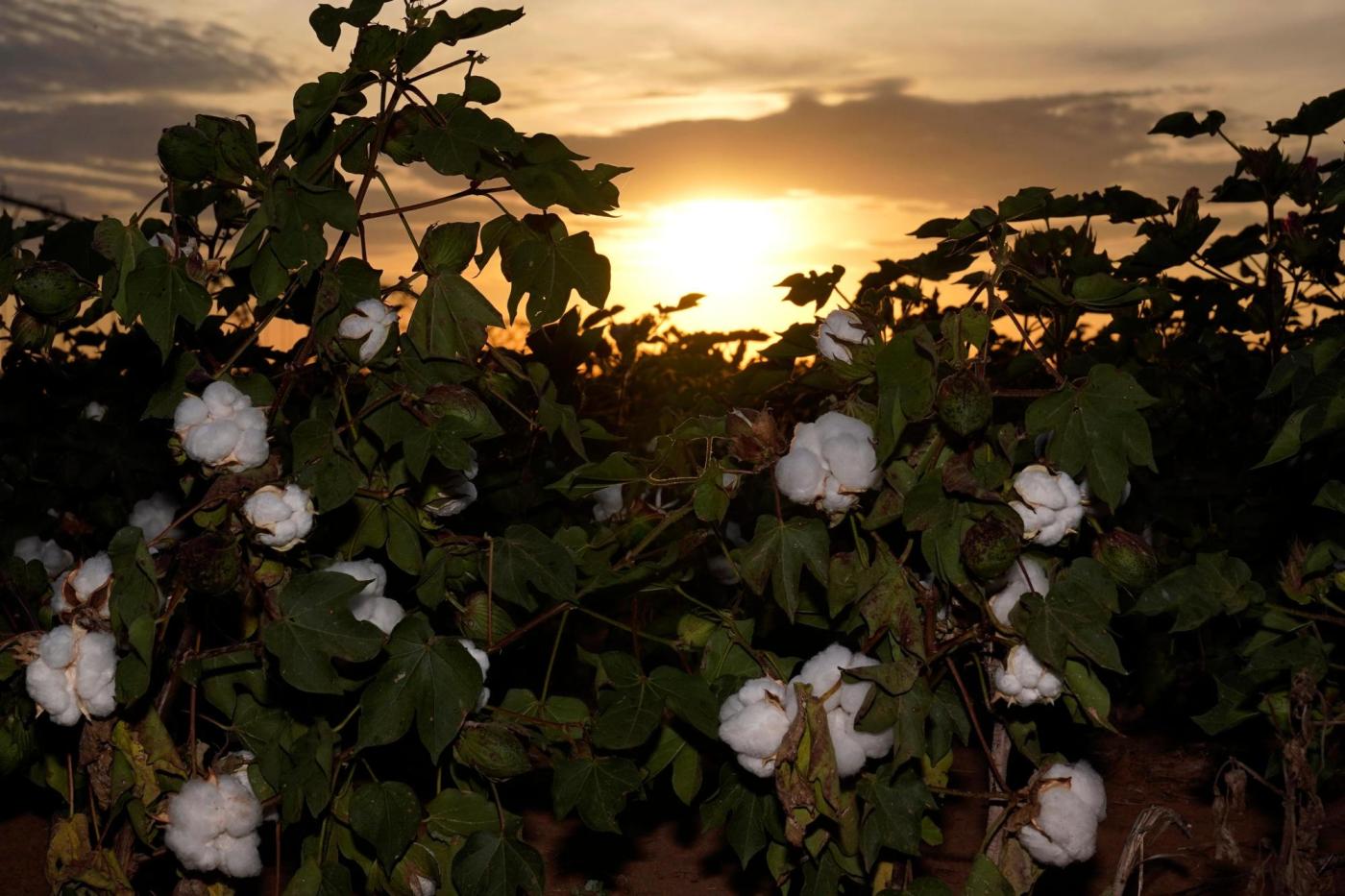LUBBOCK, Texas — The cotton harvest is about to get underway in the Texas High Plains, the windswept region that grows most of the crop in the nation’s top cotton-producing state. But Barry Evans, like many others, has already walked away from more than 2,000 acres (809 hectares) of his bone-dry fields.
“It just didn’t come up. We hardly had anything. It just wasn’t in the cards this year,” said Evans, a third-generation cotton grower.
Extreme heat and a dearth of rainfall have severely damaged much of this year’s cotton harvest in the U.S., which produces about 35% of the world’s crop. The U.S. Department of Agriculture forecast that more than 40% of what U.S. farmers planted in the spring would be abandoned because of drought. Nowhere is this more apparent than the flat, dry stretch of Texas extending some 250 miles (402 kilometers) from Lubbock to the tip of the Texas Panhandle bordering Oklahoma.
Where waist-high cotton plants normally grow, the landscape is now defined by barren, brown fields. The USDA says Texas cotton farmers are likely to abandon nearly 70% of their spring planting. That’s the worst harvest since 2009, according to the Texas Farm Bureau.
The losses in cotton could cost the Texas High Plains $1.2 billion after farmers receive federal crop insurance payments, estimates Darren Hudson, director of the International Center for Agricultural Competitiveness at Texas Tech University. That leaves out others who depend on the crop, such as cotton gins and warehouses. “Any time you have a bad year in cotton, it has a role to play in the overall economy,” Hudson said.
The region normally receives around 18 to 20 inches (46 to 51 centimeters) of rain per year, but saw less than 3 inches (7 centimeters) of rain from August 2021 through the summer, as nearly all of Texas baked under drought and blistering temperatures sapped the remaining moisture from the ground. Climate change is intensifying these effects.
“Subsoil moisture and topsoil moisture was already low to start, and it just got worse and worse,” said Graham Soley, a USDA agricultural economist.
In Texas, bad drought years are recalled with a certain familiarity. Evans and other cotton growers say the soil was so dry in April and May, when cotton’s planted, that the harvest fared worse than in 2011, the last time a drought almost as severe enveloped the state.
“If we don’t get any kind of winter moisture, it’s going to be really difficult next year,” he said, adding that there’s less groundwater available in the High Plains area than a decade ago.
Much of the cotton grown in the region is rainfed, but some cotton farmers also use groundwater. Even those with irrigated fields are expecting low yields this year.
Katie Lewis, a professor of soil chemistry and fertility at Texas A&M University in Lubbock, said extreme heat and dry events are growing more intense, but not necessarily more common.
The region’s arid, sandy soils and high rates of moisture loss from evaporation and plants means rainfall can change soil conditions for farmers fairly quickly, Lewis said. So if this winter provides enough rainfall, next year’s harvest could look very different.
“But the patterns of weather events have become so sporadic,” she added, “that it’s hard to define normal.”
Even if crop yields rebound, the region’s overall recovery from economic losses could take a few years, particularly small towns that are especially dependent on cotton. “Consecutive bad years really damage the economies of the rural areas,” said Texas Tech’s Hudson.
While most farmers facing losses have already received federal crop insurance payments, such backstops don’t exist for the cotton gin operators who separate seeds from harvested bolls, warehouses that store cotton bales, mills that make cottonseed oil, or trucking companies that transport the crop.
Todd Straley, who manages a cotton gin in Plainview, Texas, said his region has experienced five years of below-average harvests that have accelerated the closure and consolidation of nearby facilities.
His gin normally produces around 100,000 bales each harvest; this year, he is expecting to process 12,000. As a result, Straley has no need to run the facility 24-hours-a-day as he normally would for the three months after the harvest.
“We are looking at such a short crop,” Straley said, “I contracted my employees to dismantle different gins that went out of business.”
While U.S. cotton farming is no longer labor intensive, cotton gins, warehouses and oil mills depend heavily on seasonal workers, usually migrant laborers. Straley said he’ll need around 18 full-time and seasonal workers, compared to 50 in years when farmers haven’t abandoned crops at such high levels. Farmers choose not to harvest when so little grows that it isn’t worth the cost.
Larry Black, who manages a ginning co-operative in Roscoe, Texas, about 150 miles (241 kilometers) away, said his facility processes cotton from 100,00 acres (40,469 hectares) of nearby farmland. Last year, the facility processed 86,000 bales. This year, he is expecting around 4,000.
“It’s tough on everybody when we don’t make a crop,” Black said. He estimates losses this year at the farmer-owned gin will amount to $1 million, but said profits from a strong harvest in 2021 would serve as a buffer.
In the 1980s, around 500 cotton gins were operating in the state, according to Hudson. Last year, 185 were in business, the Texas Cotton Ginners Association said.
The reduction is due in part to consolidation and changes in technology, Hudson said, “but some of that is also weather driven. Especially the smaller ones just can’t continue to stay open and operating.”
Most cotton farmers in this part of Texas use cotton seed varieties modified to withstand drought, said Kody Bessent, chief executive of Plains Cotton Growers, representing growers in 42 Texas High Plains counties. Varieties are continuously developed and will be tweaked to generate high yields if dry conditions persist, he said.
“Even though it’s drought resistant,” Bessent added, ”we still have to have a little bit of help from Mother Nature.”
Naishadham reported from Washington, D.C.
Join the Conversation
We invite you to use our commenting platform to engage in insightful conversations about issues in our community. We reserve the right at all times to remove any information or materials that are unlawful, threatening, abusive, libelous, defamatory, obscene, vulgar, pornographic, profane, indecent or otherwise objectionable to us, and to disclose any information necessary to satisfy the law, regulation, or government request. We might permanently block any user who abuses these conditions. As of June 15, 2022, comments on DenverPost.com are powered by Viafoura, and you may need to log in again to begin commenting. Read more about our new commenting system here. If you need help or are having issues with your commenting account, please email us at memberservices@denverpost.com.






